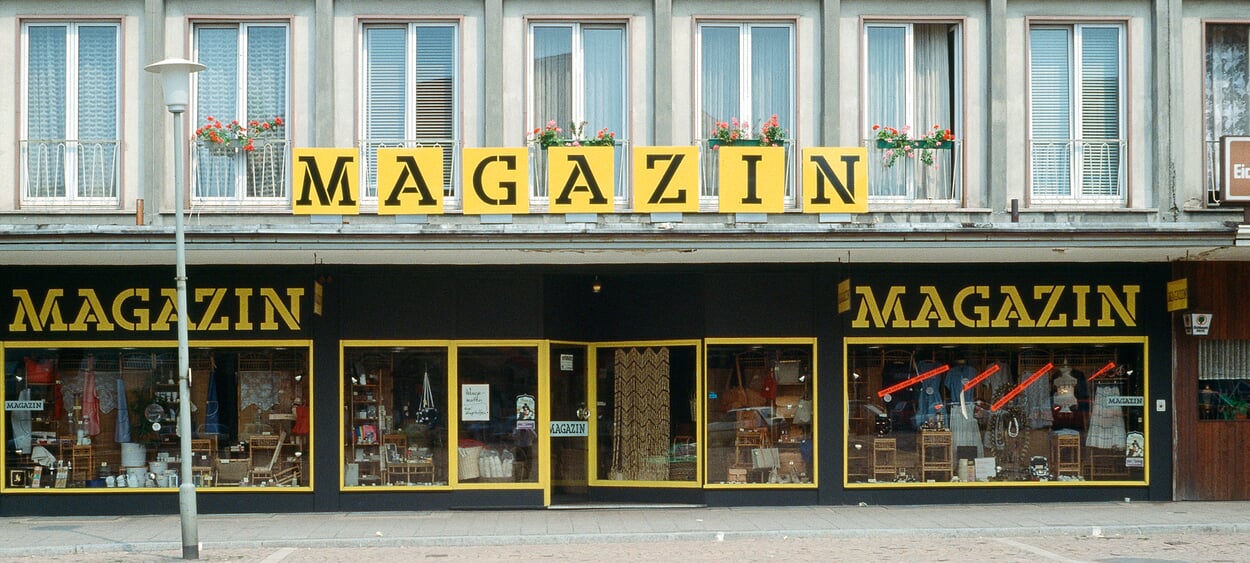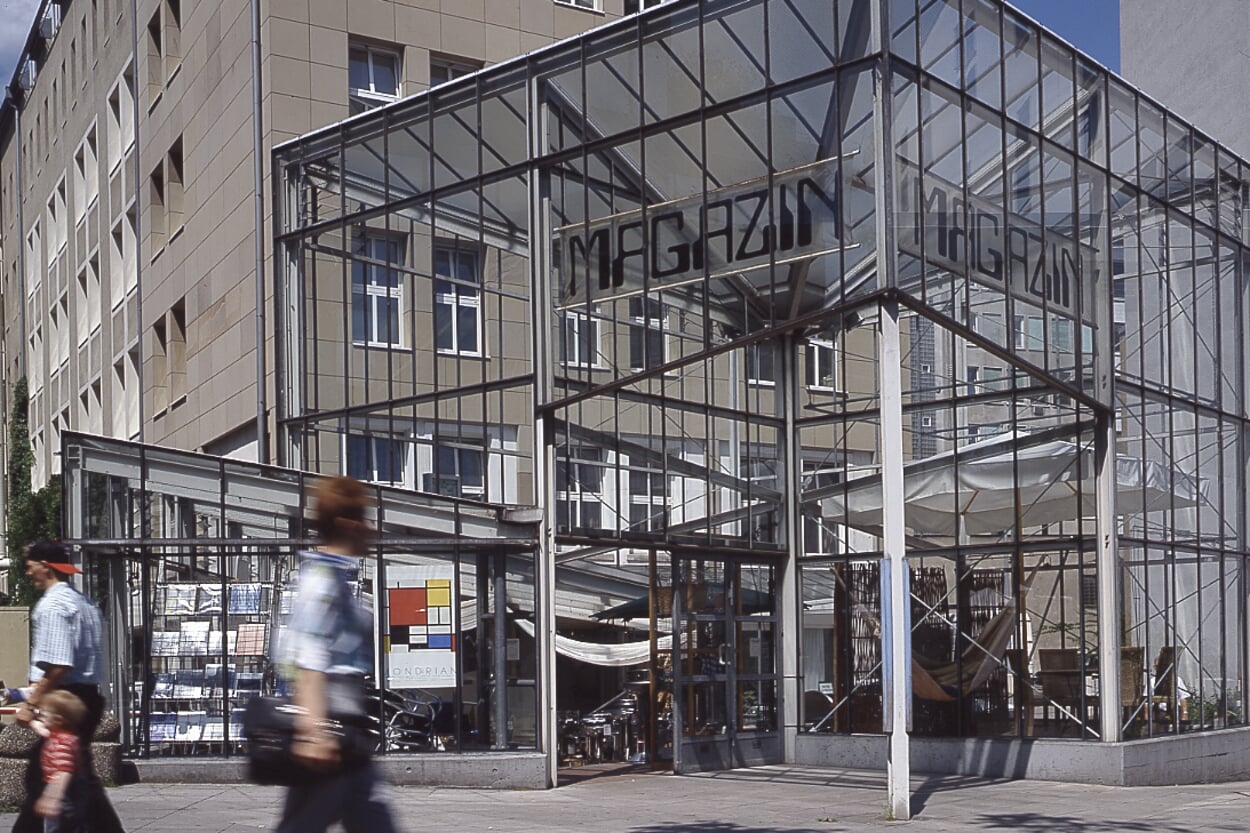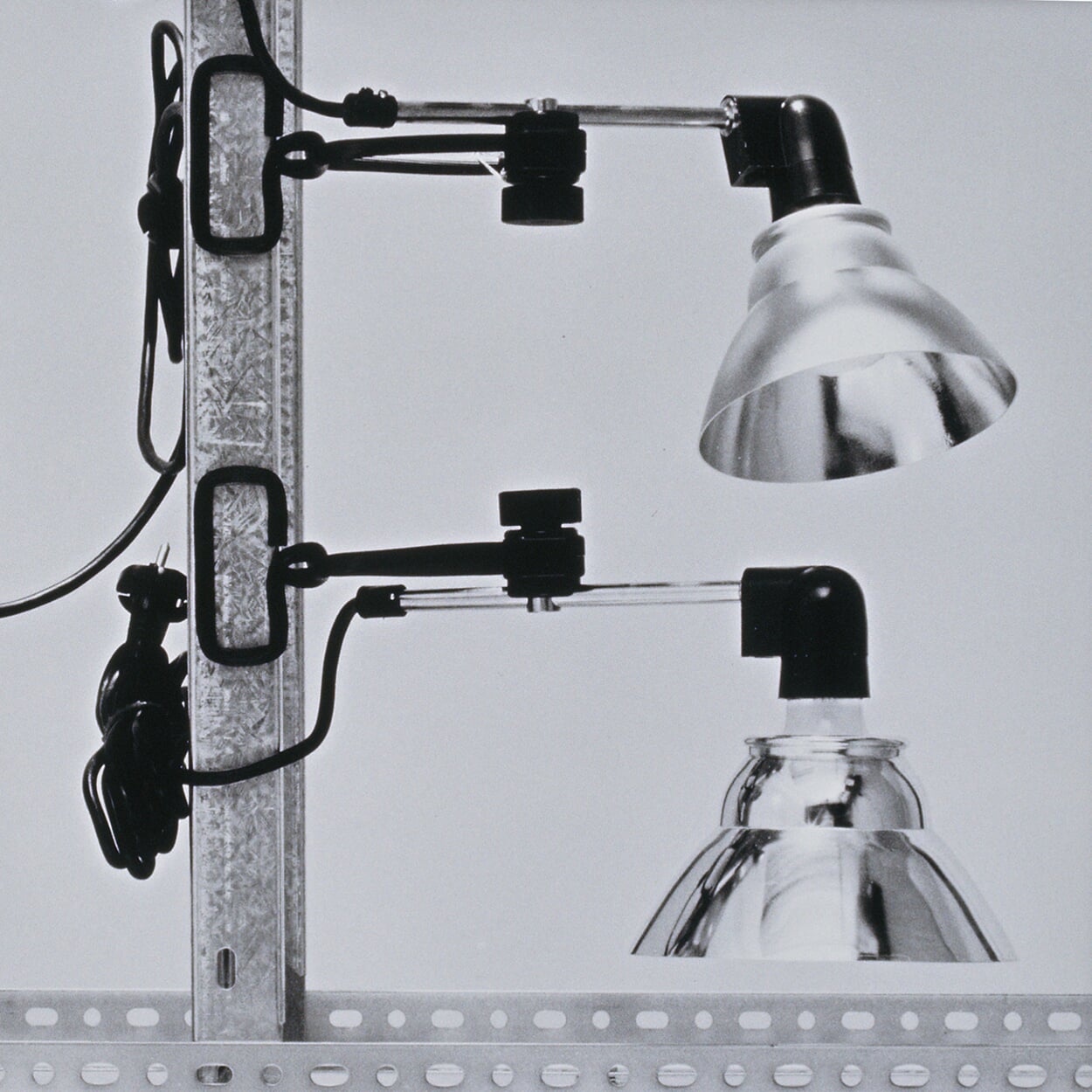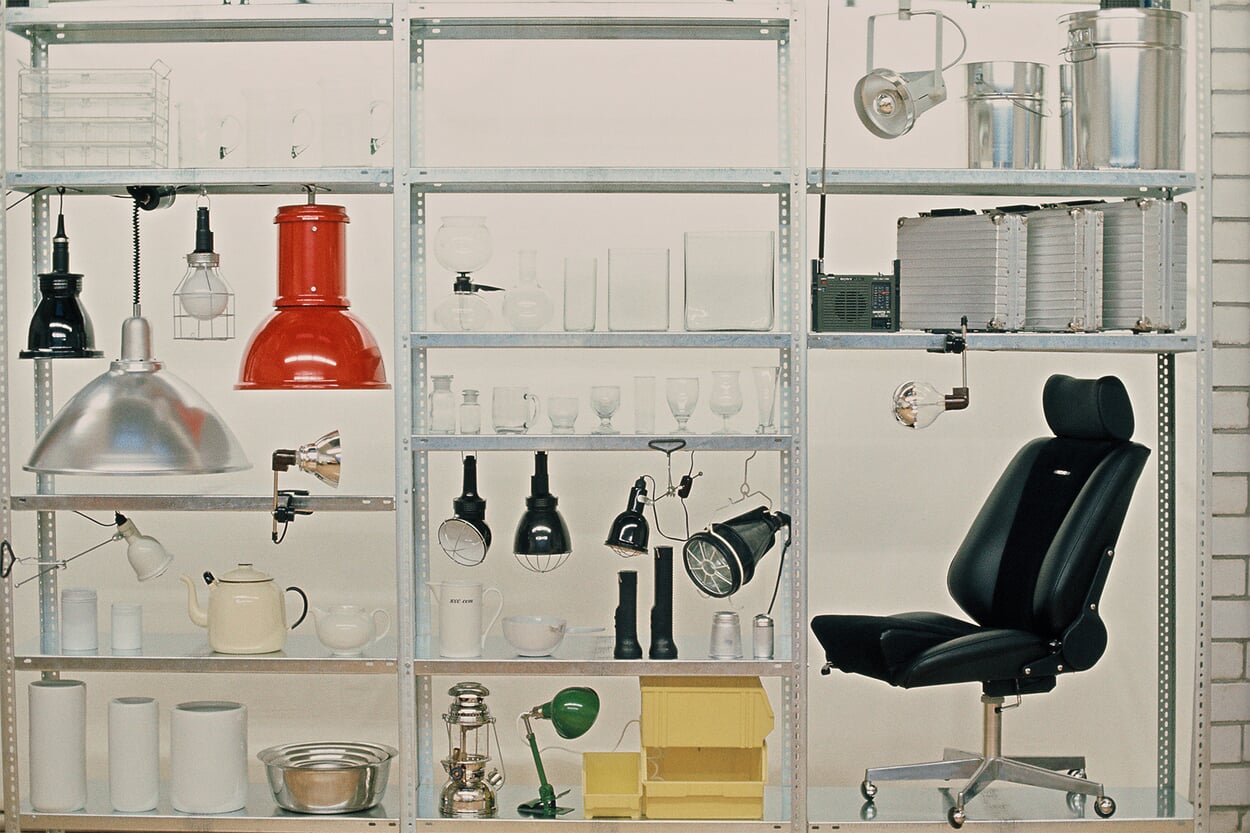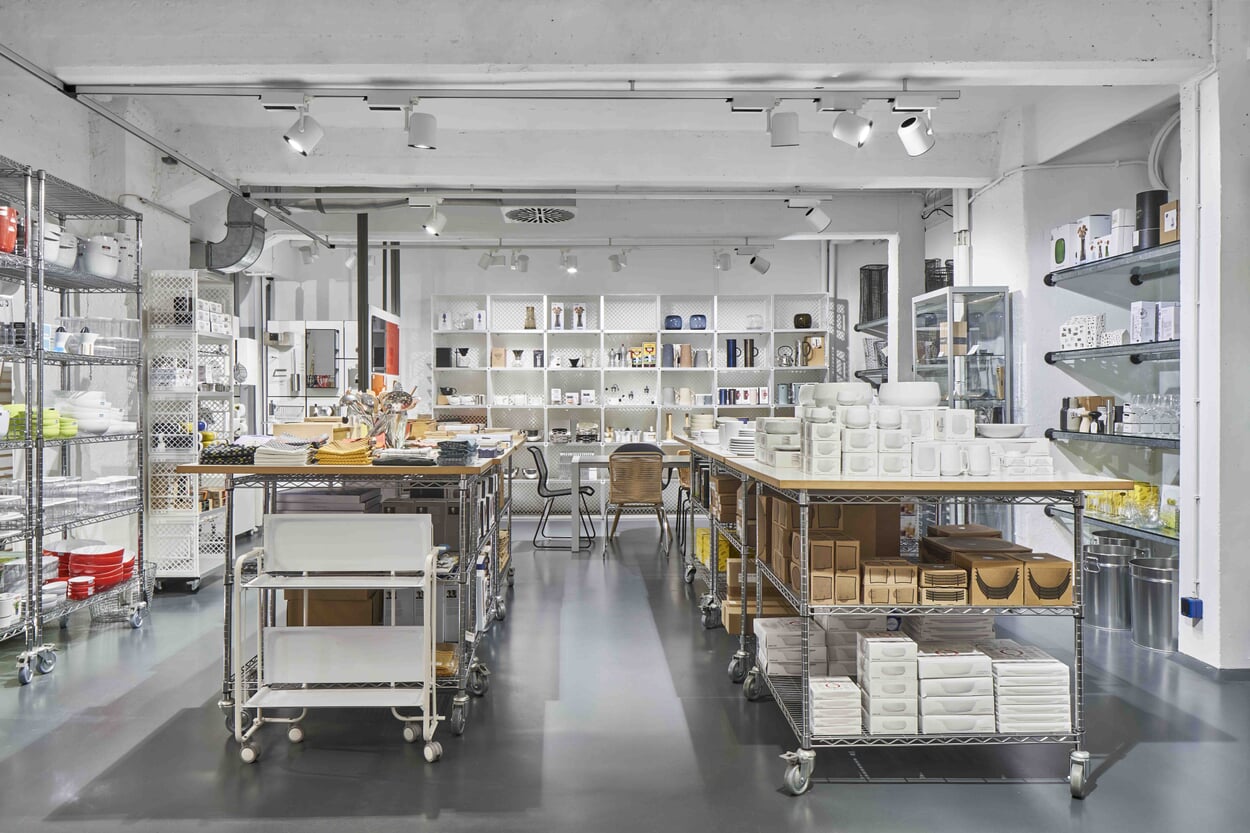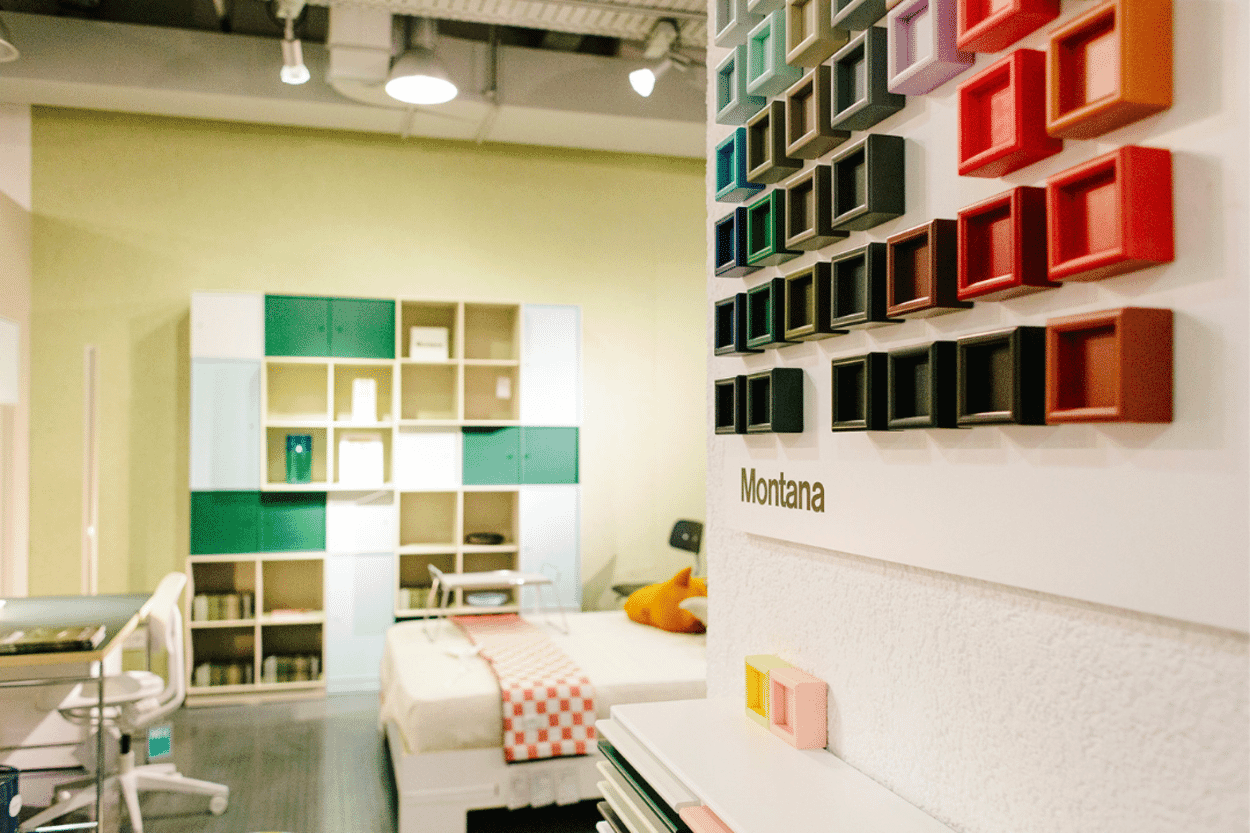Magazin History
The importance of the useful
MAGAZIN was founded in Stuttgart 50 years ago. A store, an idea, a program formed an innovative company with stubbornness and perseverance.
In the beginning there was criticism. You can call it discernment. Immanuel Kant speaks of judgment. In the spirit of the protest movement, MAGAZIN was founded in Stuttgart in 1971. When a young generation set out at the end of the sixties to change conditions worldwide, they did what generations before them had already done. They tried to find their own position in the world. What they found was not only already formed, it was rigid and unchangeable. They met this fixed universe with unease and rejection. The only question was how to unhinge it and replace it with something different, something better. Mass media such as television and unifying cultural interests meant that their protest attracted worldwide attention and became effective. The confrontation with authorities and supposedly good customs and traditional forms led to a new culture of protest. The upheaval of this movement at the beginning of the 1970s gave rise to all kinds of seekers of meaning. From esotericism, politicized groups, reformers and revolutionaries to terror, an immense range of activities developed. They aimed to change the big picture. If these could not be achieved, at least the individual was supposed to reconceive and reshape themselves. And the result was MAGAZIN.
TRADE AS A FIELD TEST
If you ask Otto Sudrow about the story of how it came about, he goes into great detail. And he has to. Because before the first MAGAZIN opened in a backyard in the middle of Stuttgart's city center near the Hans-im-Glück-Brunnen, students and research assistants at the State Academy of Fine Arts, including Otto Sudrow and Auwi Stübbe, thought about how they could bring their findings and research from the university into contact with everyday life, with reality. "The academy was a kind of sandbox in which we played. We knew nothing about reality," remembers Otto Sudrow. There were many starting points for criticism around 1970. The studies at the academy, which were organized according to master classes, seemed outdated, not only because they ended without a diploma, even for architects. In design courses, there was neither an upstream foundation course nor regular theory courses. So they got together and spent a year and a half reading the first volume of Karl Marx's "Capital", subtitled "Critique of Political Economy". They not only hoped that theory would give them a better insight, they also hoped for "support and encouragement", as Sudrow recalls. What they wanted was a more scientific approach to their studies. For some, the disappointment was great when the philosopher Wolfgang Fritz Haug, who had previously encouraged many to read Marx, published his "Critique of the Aesthetics of Commodities" in 1971. It read: Design "maintains the general disfigurement through a particular design." What's more, it "performs facial care and thus, by having a beautifying effect in some places and upholding morality, prolongs capitalism like the Red Cross prolongs war."
"The academy was a kind of sandbox in which we played. We didn't know anything about reality."
A statement that led many budding designers to abandon their studies and move into other fields that seemed less stressful. Sudrow was not deterred. He not only studied Marx, but also Wilhelm Wagenfeld. In 1965, Wagenfeld wrote: "We have to start from the need for things and not from the economy, not from production, nor from any other purpose." For Wagenfeld, purely functional forms were "signs of obtrusive poverty". He contrasted this with his idea of use: "Use is different. It connects us with things in a more light-hearted, diverse and intimate way, draws them into our world, our everyday life, Sunday, feast day!" Sudrow combined this emphatic idea of use with the concept of use value à la Marx. The result was a certain tool-like character that texts and things could take on.
WORKSHOP AS A GUIDING PRINCIPLE
A basic experimental seminar in the newly founded Department of Environmental Design at the university gave rise to further questions: "We considered how we could gain access to the market and the lives of consumers, and we wanted to collect data in order to gain insights for design. The store in Stuttgart was the visible part of the project." For Otto Sudrow, the perspective shifted: while others decided to go into the factory and work on the assembly line or initiate development projects in Africa, he founded MAGAZIN Warenhandelsgesellschaft für technische Güter und Einrichtungsbedarf with Antje Sudrow, Auwi Stübbe and the sociologist Günter Zimmermann. Initially, the company saw itself as the practical arm of a far-reaching university project. "All that remained was the store. Everything else was rudimentary and fell into disuse somewhere," summarizes Antje Sudrow. Nevertheless, the theoretical integration of the project was very important for Otto, even more important than for her at the time. She managed the store in Stuttgart from the very beginning and remained its face until 2006. She did not collect data, but valued the contact with customers, who provided important feedback and suggestions. Paint research and surface technology were her topics before Antje Sudrow became the founder of the company. Her expertise in materials science flowed into her new field of activity. She brought theoretical ideas conceived at the academy to life. "What you honor in the workshop is not wrong for the home," the founders had set themselves as a guideline. There were many other reasons for this besides reading Marx. One may have been that the workshop is a natural place for many creative professions. Drawings, models and designs of all kinds are created in the workshop, where they are worked out or reviewed and discarded. Creative professionals of all kinds, from graphic designers and jewelry designers to industrial designers and architects, were the first target group of MAGAZIN. Basically, however, everyone who saw themselves as progressive was looking for new everyday objects "People were fed up with the style of the time. People were convinced that the artisanal appearance of design had become obsolete. Everyone was eagerly on the lookout for something new," recalls Otto Sudrow. But there were also problems with the workshop's mission statement and its furnishings: "According to the ideals of our training, they were not beautiful. We tried to break away from them - and thus also from our teachers." Functionalist concepts, which had little market relevance at the time, were also not an alternative. The "Bauhaus aesthetic", presented on a grand scale at an exhibition in Stuttgart in 1968, was considered too elitist and authoritarian by the Sudrows and their comrades-in-arms. "As an individual, it's not so easy to replace it," explains Otto Sudrow. But it was clear in the air that there had to be viable counter-designs in the field of tension between Bauhaus, applied arts and styling.
AN ASSORTMENT IS CREATED
The word Magazin means storehouse. It is originally an Arabic word, first adopted into the Romance languages, writes the Grimm dictionary, "a place to have a supply of something". For the illustrated magazine, which is also called Magazin, Kluge, the etymological dictionary, explains that it is "a collection point (of information)". Both apply to the company MAGAZIN. It is both a collection point for information and a storehouse that opens up the market in a new way. In retrospect, this alone seems like a masterstroke: in the age of the Internet, smartphones, mail programs and messenger services, we take market transparency for granted, whereas 50 years ago it was a highly confusing matter in the foothills of industrial society. In 1971, a PC was not available anywhere, and the fax machine that is ridiculed today was irrelevant. Letters, postcards and stationary telephones were the standard means of communication. The market was a black box: "You only got to see products when they were in the shop window," remembers Sudrow. Trade fairs were only accessible to trade visitors. Retail acted as an absolute filter. What was considered unsaleable there was practically non-existent. There was virtually no alternative to stationary retail. The mail order business of 1971 cannot be compared with the online stores of today. In short: "You didn't get a true picture of production," summarizes Otto Sudrow. To research contact addresses, you went to a main post office and worked through telephone directories and printed "Yellow Pages" for a particular area. Or they obtained comprehensive printed directories such as "Who delivers what?", which cost several hundred marks. It was essential to have your own network based on experience and knowledge, which manifested itself in individual writing and memory systems, from notebooks to card index boxes.
The international exchange of goods hardly played a role at private level in 1971. The common European market was still a utopian dream.
But not only that: the international exchange of goods hardly played a role at private level in 1971. The common European market was still a utopian dream. Production was largely for domestic bulk buyers. "Goods from France," remembers Otto Sudrow, "were exotic for us and there were none at all from England, let alone the USA." In order to obtain relevant products from Japan, "a student traveled there for us in the 1980s, who bought products as samples in stores there and sent them to us. We laboriously researched the manufacturers and were then able to order. The fact that we were able to sell French balloon glasses and drinking glasses from the catering trade was very well received." The range had a stimulating effect, and not just on customers. Later, some discoveries from MAGAZIN became widespread top sellers. Right from the start, there were in-house developments, such as construction lights, which were technologically "overqualified". They were therefore converted to the appropriate electrical system for domestic use. There were also products that encouraged customers to become active themselves, which applied to both textiles and upholstered furniture, which could be adapted to personal requirements by creative customers as an intelligent variant of do-it-yourself. At the same time, MAGAZIN was a field for experimentation with elements of a concept store, where jewelry made from radio parts was offered, as documented in an early TV film from 1971.
PLACE OF INSPIRATION
No wonder that the MAGAZIN stores in Stuttgart soon became places of pilgrimage for all those who were looking for things other than those that were available a thousand times over on every corner. "Innovation was the most important thing for our customers," remembers Antje Sudrow, "They asked 'What's new' and 'What can we look at' when they came into the store on Saturdays. Some told us about things they had seen elsewhere, 'that would be something for you'." Initially, MAGAZIN was an insider's business, an insider tip and not easy to discover. The backyard building has rubber studded floors like those at Frankfurt Airport. The walls made of corrugated aluminum sheets look like the inside of a container. The world of MAGAZIN is uncolored. Black, white or matt silver like steel shelves, which are quickly becoming a hit. "It was a new world for us too and we were totally thrilled," recalls Antje Sudrow. "We discovered construction site luminaires as a source of light. And that was fantastic! We placed the steel storage shelves on Persian carpets. It was all very exciting for us back then. And we always found something new. There were porcelain ice cream containers that we sold as umbrella stands." At the same time, MAGAZIN demanded imagination from its users and customers. Furniture was not used to recreate living scenarios, but rather an "atomistic arrangement", as Antje Sudrow calls it, with tables next to tables and chairs next to chairs. A new location was added in 1975 and was soon to replace the first. They moved into the former branch of the Deutsche Bau- und Bodenbank at Lautenschlager Straße 16. However, the new prestigious premises were in urgent need of a makeover: granite and black and green marble: "We couldn't expect our customers to accept such an impression," Antje Sudrow noted. As a result, the marble was covered with chipboard on the floor and room-high on the walls. Wooden shelves, rather than steel, now dominate MAGAZIN.
Industrial luminaire
Apothecary bottle
Bentwood chair
ATTRACTION OF THE USEFUL
In the same year, 1975, Stephan Dornhofer, the current managing director of MAGAZIN, began his training as a furniture salesman in a Scandinavian furniture store. On his first day, he carried around a pile of Arne Jacobsen chairs, arranged Erik Magnussen armchairs in the showroom and dealt with the teak sideboards that are now "rocketing through the roof in vintage stores". For him, they are "bourgeois attribute furniture". The fact that they are among the most hyped items in trendy Berlin residential areas makes him smile. At the end of the 1970s, he travels from the Rhineland to an evening event in Stuttgart. After all, MAGAZIN has long been offering lectures, events and exhibitions. Especially since the space available at Lautenschlager Straße 16, the current location, allows for this and the productivity of the space, which was previously "almost as high as in a bratwurst stand", as Otto Sudrow recalls, decreases dramatically. An opportunity for the further development of MAGAZIN into a creative platform: the designer friends Otl Aicher and Norman Foster appear here together, the architect and author Peter Sulzer presents his research on the complete works of Jean Prouvé at the end of the 1980s. Rita Limacher ran her legendary bookshop for architecture and design at MAGAZIN for a long time. The glass pavilion designed by architect Dieter Hermann using system elements from greenhouse construction gave the store iconic qualities. As a greenhouse for new ideas, the pavilion ensures visibility in the urban space.
ENTHUSIASTIC INDIVIDUALISTS
It is impossible to continue the following story without gaps right up to the present day. MAGAZIN not only inspired customers, but also retailers or those who wanted to follow suit. Sooner or later, they all came to Stuttgart to get to know the concept, range and vision of the MAGAZIN founders. The sisters Gunde Rietkötter and Anne Imbusch, architects who had studied in Stuttgart, were the first to open MAGAZIN in 1975, with Düsseldorf as the location. This was followed by MAGAZINE in Cologne, Bonn and other cities. Many of the founders were inspired by the original idea, but primarily targeted buyers from their region. Should they take action against competitors operating under the same name? Antje and Otto Sudrow opted for an "embrace strategy". Stephan Dornhofer describes it as an unusual generosity with which the Stuttgart-based company provided information about their business model. In an industry that is not exactly known for cooperation among competitors, they disclosed the "source code of their business model". And not only that, they supported the movement that felt more or less connected to the MAGAZIN idea. But they were also followed by rather uninspired imitators with "design kitsch" and plagiarized products. It was important to keep a distance from them. The others, who shared the same values and attitude, gathered around the Stuttgarters to form a loose network of individualists. Many of these enthusiastic store owners appeared under the common programmatic name, some of them deliberately not. They produced MAGAZIN catalogs together, and attending trade fairs was also more collaborative. Nevertheless, the coordination within the network, which was based on personal meetings, took up a lot of time and was dissolved at the end of the 1990s.
IN THE DIGITAL AGE
"Online" became both a magic word and a scary word. Customers were given new power and sovereignty, which they did not always use wisely. Advice, direct contact, exchange and mutual inspiration were in danger of being lost. In addition, online stores demanded massive investments at the turn of the century, without coherent multi-channel strategies appearing achievable for small individual players. For many of the stores, this meant the end. Antje and Otto Sudrow made contact with Manufactum. The cooperation began with a Manufactum sales area in Stuttgart MAGAZIN. The elective affinity between two "soulmate initiatives" became an institutionalized cooperation under company law. The Sudrows continued to work in the company in an advisory capacity. Stephan Dornhofer became managing director together with the new partner. As a connoisseur of the beginnings and their protagonists, he maintains the uniqueness of the concept, which friends of the company still describe as an attitude today. In 2006, Manufactum took over all shares in MAGAZIN, intensified the successfully established cooperation and provided MAGAZIN with online expertise. In addition to the stores in Stuttgart, Munich and Bonn, this was a good basis for continuing many of the original ideas, such as the in-house development and production of MAGAZIN products and the strict product range selection, into the future. "Designers are able to innovate and make things even better by being critical," emphasizes Otto Sudrow. It is a law of motion of design that it is constantly being optimized, that its use is optimized, because someone can always go one better." And so the motto: "Everything can be done much better" is an optimistic incentive for us all - not just for MAGAZIN. This text is an excerpt from the book "50 Jahre 50 Produkte - Designgeschichte(n) erzählt von MAGAZIN".
50 years - 50 products
The book on MAGAZIN! 50 years of MAGAZIN encourage a special look at topics and products, stories and topicality. Founded in Stuttgart in 1971, MAGAZIN has experienced and written history. Companions and contemporaries, product designers, customers and lovers of the brand have their say on what has happened. A collection of essays, e.g. by Sibylle Berg on "Schöner Wohnen" and Maxim Biller on "Erinnerungen von Morgen", meets contemporary topics on product design, design and furnishing. Supplemented by a special look at 50 exemplary products from the history of MAGAZIN. Including the popular and the little-seen, highlights and the inconspicuous, the favorite products of MAGAZIN and their background stories.
FURTHER INFORMATION
We share a common attitude with all our manufacturers: we sell well-designed products and take a critical look at materials and manufacturing processes.
Are you planning a major interior design project? Are you an architect, interior designer or entrepreneur? Then get in touch with us!
In our stores in Stuttgart, Bonn and Munich, you are right in the middle of the world of MAGAZIN products. Take a look at what interests you, touch the products and try them out.







